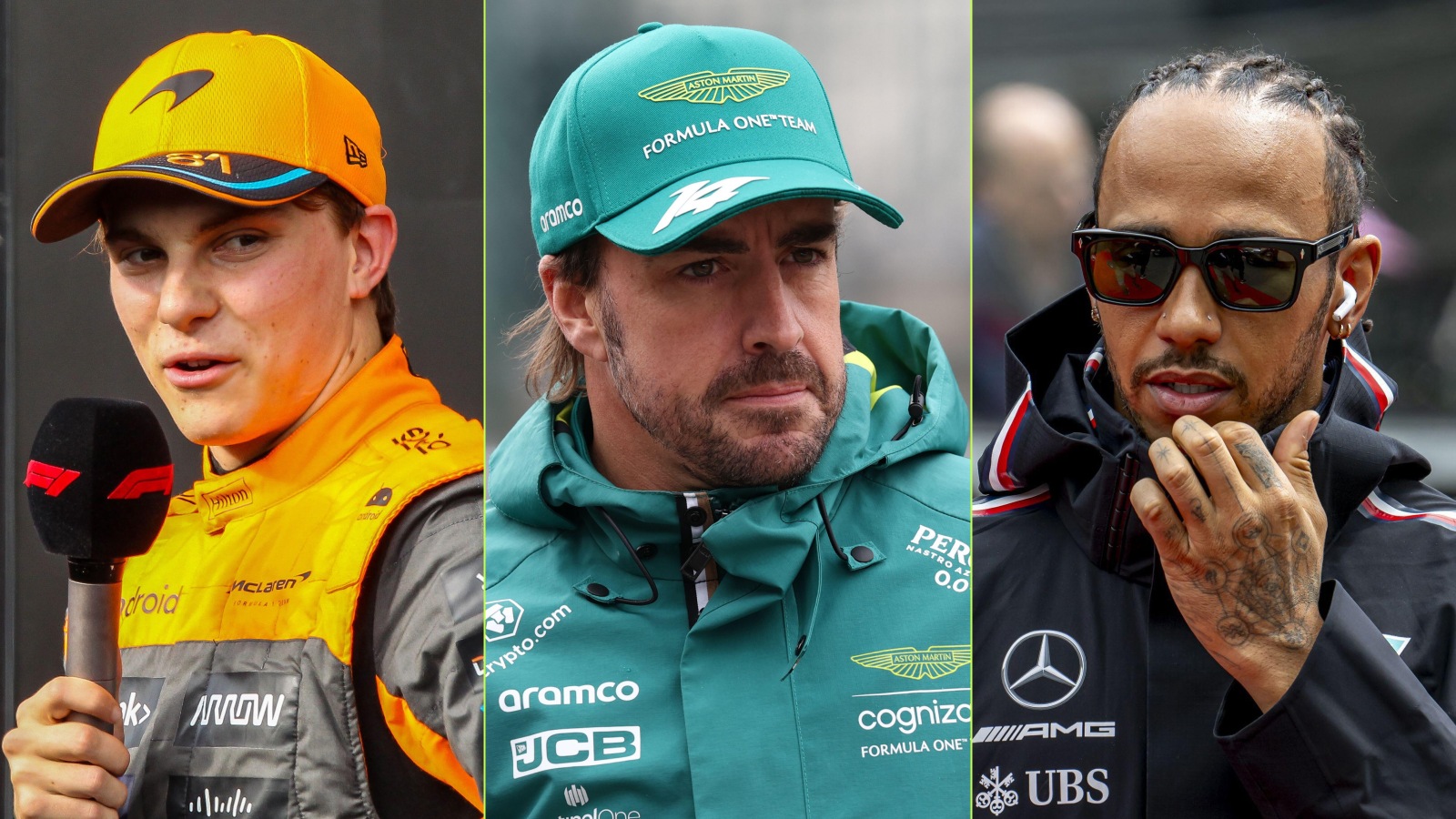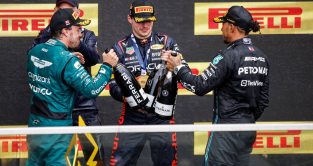Lewis Hamilton bias, Aston Martin-Honda and best rookie season – Your F1 questions answered

You asked, we answered! Having waded through your questions, we’ve picked out the best and answered down below.
PlanetF1.com’s paddock journalists Sam Cooper and Thomas Maher are on hand to answer all your queries from Aston Martin’s Honda deal, best rookie season and even the 1999 Drivers’ title.
Didn’t ask a question this time? Head to the comments section and get your F1 questions and queries in for our next edition.
Your questions to PlanetF1.com answered
John – So maybe covered in past, how are the teams, tyres, cars, people, etc. transported from one location to the next? How much $ to do so.
SC– The answer to this question is best separated into two parts and that is down to what kind of race it is.
In Formula 1, you have two kinds of race weekends, a European race and a flyway race. The difference is quite clear from the names but for every non-European race, teams will fly to the circuit and it is not just personnel they are shipping.
While teams can get from A to B by road for European races, it is a different story as to how they get from say Saudi Arabia to Australia. Over the course of the season, teams will ship 660 tons of air freight and 500 tons of sea freight so when it is claimed Formula 1 needs to cut its carbon footprint, it is this area that is focused on rather than cars on track.
These boxes of freight will arrive at a circuit in the days leading up to the race and the teams will quickly unpack and assemble it all ready for the weekend. If you ever around at a track after a grand prix on a Sunday, you will see the pit lane full of lorries as the teams unpack and head for the next stop.
It is hard to put an exact figure on how much money it costs to do this but it is not cheap! Sports and business reporter Joe Pompliano has suggested it is around $100m.
John Patrick – What is your opinion on the Aston Martin-Honda deal?
TM – It’s a good move for both parties, in my opinion. Honda’s F1 project, through the indecisive humming and hawwing being done at corporate level, had put in all this work and effort with Red Bull, and reached the top.
Red Bull, through no fault of their own, were left high and dry while Honda remained in a type of holding pattern by continuing as a supplier but also… not really a supplier!
But the new engine regulations for 2026 clearly have been tempting, and Honda are fully back on board – the difference being that it will be Honda Racing Corporation (HRC) taking care of the supply, rather than the parent company. This means there should be more certainty regarding their F1 involvement in the longer-term, rather than the last two times they’ve proven a bit flakey.
On Aston Martin’s side, the burgeoning growth of the team under Lawrence Stroll has proven he’s not willing to play second fiddle to anyone. Being a Mercedes customer had clearly run its course after some 15 years of the Silverstone-based squad running engines from Brixworth.
The tie-up with Honda now means Aston Martin have a fully exclusive works deal with an engine manufacturer that are currently at the top of the hybrid tree – even if it took a few years to get there.
However, the question mark I have is related to Geely, the Chinese automaker that are shareholders in the Aston Martin parent company. By 2026, what will their involvement be? There have been whispers that they could be seeking to increase their involvement over the next little while…
Timothy – With Piastri having an amazing rookie season, who would you say has had the most impressive rookie season in the history of F1?
SC– For me, I think you have to go back to 2007 and Lewis Hamilton’s arrival into the sport.
Aside from Nina Farina who won the first ever season of F1 at the age of 44, no rookie has secured the title in their first season but Hamilton came oh so close.
At the age of 22 and alongside the reigning World Champion in Fernando Alonso, it could have been expected Hamilton would take the backseat and get to grips with the sport but nine podiums and two wins in his first nine races quickly blew that suggestion out of the water.
In the end, Hamilton would win a joint record four races that year and fall just one point short of the title before going all the way in 2008.
Dave – What fallout can you see when FIA say Andretti motorsports bid is successful and Stefano Domenicali says no new teams can enter ? Or do you think they will be accepted onto the grid ?
SC– I have always been quite pessimistic about the chance of other teams getting on the grid and right now, I would say the odds of it happening are 80% against.
In Andretti’s defence, I think they have absolutely done everything that is asked of them whether that is working with a brand like General Motors and now this Expression of Interest process but the existing teams just do not want another hand taking a portion of the pie.
In terms of the FIA vs FOM debate, I think we would be in for a rocky period of their relationship should the FIA give the green light and FOM say no. As for the fan perspective, I would imagine a number would be annoyed at FOM’s denial over Andretti, especially American fans who feel F1 is interested in their money but their teams.
Jack – Are the new regs a success or failure? Two years in and the racing isn’t much better than the last rules set.
TM – Overall, I’d say the switch to ground effect has been a success in terms of cars are able to follow and race each other more closely without the same issues as in the past.
But last year’s technical directive, followed by the official rule change for 2023 that took aim at porpoising, put a spanner in the works by shifting the balance back a little towards over-body downforce – the more turbulent way of generating downforce.
There’s also the fact that there is a greater pace disparity between some of the cars (well, mainly Red Bull) meaning that the success of the new regulations isn’t very obvious.
It’s only the second year of the regulations, and we’re still seeing teams rolling out concept changes or admitting defeat to swap over to the Red Bull philosophy. The big word in F1 is ‘convergence’, and it’s going to take a few more seasons for every team to reach the theoretical limit of the regulations and, therefore, all be far more competitive with each other.
The annoying thing about it is that it’ll probably come just as the regulations change again for 2026…
Clyde – So when is the media going to finally come out and say that Lewis Hamilton was only as good as his car?
SC – The car vs driver debate is always going to rumble on but I disagree that Hamilton is only as good as his car. A team like Mercedes is not going to keep a passenger in one of their seats and Hamilton has a great record against pretty much every team-mate he has ever driven against.
Yes, the W13 and the W14 are two of the worst cars of his career but he has at least secured a pole this year and Hamilton is only one of four non-Red Bull drivers to have finished P2 this season.
As Toto Wolff often says, the best cars are driven by the best drivers because they are the best drivers.
VuukleUser – At the moment we hear a lot about teams putting resources towards 2024 and forgetting about the current championship, is there any changes to the rules in 2024 that will impact teams?
SC– After the mass overhaul in 2022 and further tweaks in 2023, the regulations for 2024 are very similar to the ones teams abide by this year.
One of the big changes could have been the removal of tyre blankets but that has been pushed back, meaning teams can build on what they have already got rather than starting from scratch.
The reason why teams are starting to focus on next year already is that for those comfortably in a position, they want to get a head start on the complicated process of building an entirely new car.
Xmotor – Shouldn’t F1 award points through 12th place? It can make a big difference in the finishing position of the drivers and teams that typically fight to get to tenth for that single point, but only get to eleventh. With millions between finishing positions for the bottom half of the grid, it seems only fair to the teams.
TM – If we’re going to 12th, we might as well go to 14th. If we’re going to 14th, might as well go to 16th. And sure if 16 cars can score points, might as well make it all of them!
The cut-off point needs to be somewhere, or nowhere. 20 years ago, only the top six scored points, before it was increased. The current setup covers half of the field, so that seems as good a target as any for the lower half of the grid.
Jak – Why can’t F1 go to Sakhir’s short track instead of the normal Sakhir inner track?
TM –No real reason why they can’t, given that the track itself is an FIA Grade 1 layout. But the reason it was used in the first place was due to Bahrain hosting two races in the COVID-affected 2020 season, meaning there was a desire for a little bit of variety and spice.
现在回到常态,只有一个种族在calendar, the Bahraini organisers want to run their normal layout and F1/the FIA have no real reason to argue with that. But wouldn’t it fantastic to revisit that crazily fast karting track layout again?!
VuukleUser – Was Heinz Harald Frentzen with a true shot of winning the 1999 Drivers’ title in the Jordan Mugen Honda before lights out in Nurburgring?! What led to the Jordan Grand Prix decline?
TM –Yes, he was. But only because of it being an unusual season with Michael Schumacher side-lined for half of it, and McLaren/Mika Hakkinen making life very difficult for themselves.
Aside from Hakkinen throwing it off the road every time he drove his car in Italy, he had his wheel fall off at Silverstone while leading, and McLaren didn’t do enough to stop David Coulthard from making life difficult for him in Austria and Belgium.
With neither McLaren nor Ferrari at their best, it allowed Frentzen and Jordan to launch a legitimate title challenge. Fortuitous? Yes. Deserved? Also, yes.
But, in the end, Frentzen ended up roughly where he rightfully should have – fourth place overall would have been more likely had Schumacher not been injured.
As for the decline, Eddie Jordan missed out on a very lucrative Vodafone deal that instead went to Ferrari. Jordan lost money trying to fight his corner and also had to deal with paying for his Honda engines after losing his works arrangement as the Japanese manufacturer cosied up with BAR.
With massive bills and being lesser-resourced than the main players at a time when the sport was moving away from privateer entrants and into the hands of manufacturers, it was only a matter of time until a comparatively small team would end up changing hands – being sold to the Midland Group in 2004.
Trevor Fenn – Why is PlanetF1 so biased toward Mercedes and Lewis Hamilton?
SC– Sorry to disappoint but afraid there is no bias towards either Mercedes or Hamilton. Instead, we are actually all biased in favour of…(just joking, we genuinely aren’t.)
TM –I think some readers struggle to separate the journalist from the story we’re reporting. It’s our job to report what people do, say, and think in the sphere of F1 and motorsport. Obviously, not everyone will agree with those people. But us writing it doesn’t mean we think the same – we’re just reporting it.
It would be quite eye-opening for some readers to see just how often we’re accused of bias in favour of ‘insert driver here’. We can’t be biased towards all of them, can we? If you’re seeing bias, then perhaps examine your own – it might explain why you’re seeing it.






